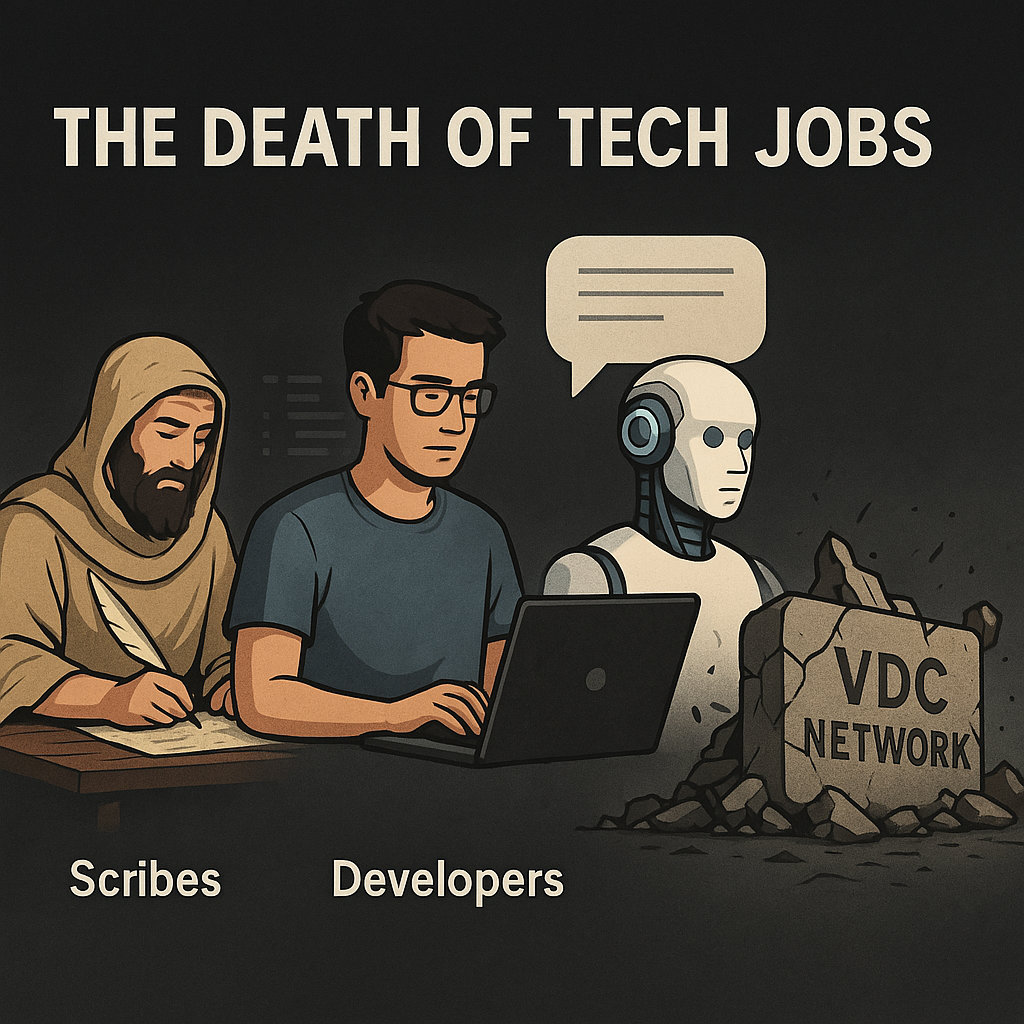I. The End of Prestige: From Scribes to Software Engineers
Once upon a time, the ability to write was a source of societal power. In ancient times, scribes were gatekeepers of knowledge, trusted to preserve the collective memory of civilization. But the printing press changed everything. Literacy became widespread, and the monopoly of the scribe collapsed.
Today, software engineers face a similar fate.
Coding, once revered as the arcane art of the digital elite, is becoming ubiquitous. The rise of AI, no-code platforms, and prompt-based development is doing to coding what the printing press did to writing: it’s democratizing access and lowering the barriers to entry. But with that access comes a brutal recalibration of value.
The message is clear: the prestige of coding is no longer tied to exclusivity. And as more people write code—or prompt machines to write it—the economic and strategic power of being “just a coder” is vanishing.
II. The Collapse of the Tech Career Ladder
For decades, the tech industry sold a simple dream: learn to code, get a degree (or go to a bootcamp), land a six-figure job, and ride the rocket ship of innovation. But that ladder has shattered.
2023 saw over 400,000 tech workers laid off. In 2024, that number surged again. The layoffs weren’t just economic corrections—they were structural signals. Companies weren’t replacing workers. They weren’t shifting talent. They were shedding entire job types and betting that machines, not people, would fill the gap.
And the shockwaves are still coming. Coders today are facing a double bind:
-
Supply explosion: Remote work, open-source education, and global talent pipelines mean anyone with WiFi can learn to code.
-
Demand implosion: Generative AI tools like Devin, GPT-4, and no-code stacks can handle tasks that once took teams of developers.
This isn't a recession. It’s a redefinition.
III. The Rise of the Prompt Engineer and the Fall of the Stack Wizard
The myth of the full-stack ninja is giving way to the reality of prompt-based engineers. You no longer need deep expertise in React, Kubernetes, or GraphQL to ship software. You need clarity, context, and the ability to orchestrate AI systems to get the job done.
Programming is being abstracted.
Just as assembly gave way to Python and JavaScript, today’s developer is being replaced not by a more skilled one—but by a smarter workflow. Devin can write, debug, test, and deploy. GPT can generate entire architectures. What matters isn’t syntax fluency, it’s system thinking.
In this world, the most valuable tech professionals are not the ones who code faster, but the ones who think better, integrate faster, and own the outcome end-to-end.
IV. The Uberization of Software Development
The traditional model—hire a team, build a product, maintain it—is being replaced by something more fluid, more networked, and more on-demand. We are entering the Uber era of tech work.
Instead of long-term employment, companies are looking for fractional engagements: solve this, build that, move on.
This means fewer full-time roles and more micro-contracts, async collaborations, and decentralized problem-solving. Engineers will increasingly be hired to solve, not to stay.
It's no longer about where you work, but how your work fits into the outcome stream.
V. The Fallacy of the Safe Career in Code
Many new entrants still believe tech is the safest bet—coding is the ultimate “future-proof” skill. But that’s a half-truth. What’s actually future-proof is problem-solving, adaptability, and outcome ownership.
Coding, like any other skill, has a half-life. What was hot two years ago is obsolete today. The half-life of engineering knowledge is shrinking fast—35 years in the 1930s, 10 years in the 1960s, now closer to 2–3 years.
Today, knowing React or Python is less valuable than knowing how to combine APIs, leverage AI tools, understand a business problem, and orchestrate a solution quickly. Language doesn’t matter. Leverage does.
The coders who survive this shift are not the ones who cling to stacks, but those who adapt to outcome-first engineering.
VI. Why Universities and Bootcamps Are Teaching Obsolescence
One reason the industry is broken? We’re training for a world that no longer exists.
Universities still teach operating system design, compiler theory, and four-year journeys into monolithic programming knowledge. Bootcamps push “get rich quick with React” curriculums that ignore the AI tsunami already underway.
Neither is preparing developers to operate in a world of:
-
Prompt-first development
-
AI-native architecture
-
Real-time global collaboration
-
Micro-task marketplaces
This education model isn’t just outdated—it’s dangerous. It creates false hope, floods the market with underprepared talent, and sets people up for disappointment. The smartest developers of the next decade won’t be those with the best CS degrees. They’ll be those with the deepest systems thinking and highest velocity to adapt.
VII. Beyond the Job: Building Leverage, Not Careers
Here’s the harsh truth: the traditional tech career is dead. The path from junior developer to engineering manager to CTO is now a pipe dream for many.
But here’s the beautiful truth: new forms of leverage are everywhere.
-
Create SaaS products using no-code platforms + AI.
-
Build income streams through content, newsletters, and micro-products.
-
Automate microservices that solve narrow business problems.
-
Partner with domain experts to co-create vertical-specific tools.
You don’t need to chase promotions anymore. You need to chase outcomes. Every solo creator, indie hacker, and lean startup proves this: you don’t need permission, you need precision.
VIII. A Better Model: Value over Vanity, Problem Solving over Programming
We don’t need more coders.
We need more problem solvers—people who can bridge business, data, AI, and execution into unified outcomes.
We need builders who don’t fetishize tools but focus on transformation.
We need generalists who move fast, specialize temporarily, and adapt endlessly.
We need to stop glorifying “tech” and start honoring value creation—because that’s the real measure of talent.
This isn’t about gatekeeping. It’s about gateway building—to a more sustainable, accessible, and decentralized tech future.
The Virtual Delivery Center (VDC) Model: How the Future Will Work
In this world of atomized tasks, AI co-creators, and declining job security, the Virtual Delivery Center (VDC) model by AiDOOS emerges as the operating system for modern work.
Rather than building bloated internal teams or relying on traditional outsourcing, VDCs form just-in-time, outcome-focused squads from a global talent pool. Think of it as Uber meets Engineering meets AI.
Each project becomes its own mini-company:
-
Structured around a business outcome
-
Staffed with on-demand talent across specialties
-
Supported by AI agents and automated delivery
-
Owned end-to-end by the platform
This is not freelancing. This is workforce-as-a-platform. And it’s where all roads converge:
-
For companies: It’s scale without overhead
-
For talent: It’s freedom with structure
-
For delivery: It’s speed, flexibility, and precision
In the age where coding isn’t rare anymore, value orchestration is the new gold. And VDCs are the new mines.

